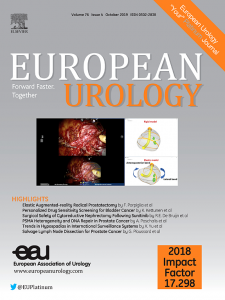前列腺癌在年轻男性中的检测:PROBASE试验中系统活检和磁共振成像活检的比较分析
IF 25.3
1区 医学
Q1 UROLOGY & NEPHROLOGY
引用次数: 0
摘要
前列腺癌(PC)筛查的最佳方法,包括理想的起始年龄和最有效的诊断方法,仍在研究中。我们在PROBASE中评估了磁共振成像(MRI)靶向活检(TBx)和系统活检(SBx)在检测45-50岁男性临床显著PC (csPC)中的诊断性能,PROBASE是一项前瞻性随机试验,用于风险适应筛查策略。共有525名前列腺特异性抗原升高(≥3ng /ml)的参与者接受了MRI和活检。在209例PC病例中,148例(71%)为csPC。SBx检出率为94%,TBx检出率为74% (p≤0.05)。SBx诊断出的低级pc也明显多于TBx (p <;0.001)。这些发现表明,单纯依赖MRI-TBx可能导致csPC的漏诊。在接受筛查的年轻男性中,联合使用SBx和TBx仍然是早期发现PC最有效的策略。未来的研究应探索优化策略,以减少不必要的活检,同时保持csPC的高检出率。该试验在ISRCTN注册中心注册为ISRCTN37591328 (https://www.isrctn.com/ISRCTN37591328)。研究方案可在https://doi.org/10.1016/j.eururo.2013.05.022上访问。本文章由计算机程序翻译,如有差异,请以英文原文为准。
Prostate Cancer Detection in Younger Men: A Comparative Analysis of Systematic and Magnetic Resonance Imaging–targeted Biopsy in the PROBASE Trial
The optimal approach for prostate cancer (PC) screening, including the ideal starting age and most effective diagnostic method, remains under investigation. We evaluated the diagnostic performance of magnetic resonance imaging (MRI)-targeted biopsy (TBx) and systematic biopsy (SBx) in detecting clinically significant PC (csPC) in men aged 45–50 yr in PROBASE, a prospective, randomized trial of a risk-adapted screening strategy. A total of 525 participants with elevated prostate-specific antigen (≥3 ng/ml) underwent MRI followed by biopsy. Of the 209 PC cases detected, 148 (71%) were csPC. SBx identified 94% of csPC cases, while TBx detected 74% (p ≤ 0.05). SBx also diagnosed significantly more low-grade PCs than TBx (p < 0.001). These findings suggest that relying solely on MRI-TBx may lead to underdiagnosis of csPC. Combining SBx with TBx remains the most effective strategy for early detection of PC in young men undergoing screening. Future research should explore optimization strategies to reduce unnecessary biopsies while maintaining high detection rates for csPC.This trial is registered on the ISRCTN registry as ISRCTN37591328 (https://www.isrctn.com/ISRCTN37591328). The study protocol can be accessed at https://doi.org/10.1016/j.eururo.2013.05.022.
求助全文
通过发布文献求助,成功后即可免费获取论文全文。
去求助
来源期刊

European urology
医学-泌尿学与肾脏学
CiteScore
43.00
自引率
2.60%
发文量
1753
审稿时长
23 days
期刊介绍:
European Urology is a peer-reviewed journal that publishes original articles and reviews on a broad spectrum of urological issues. Covering topics such as oncology, impotence, infertility, pediatrics, lithiasis and endourology, the journal also highlights recent advances in techniques, instrumentation, surgery, and pediatric urology. This comprehensive approach provides readers with an in-depth guide to international developments in urology.
 求助内容:
求助内容: 应助结果提醒方式:
应助结果提醒方式:


